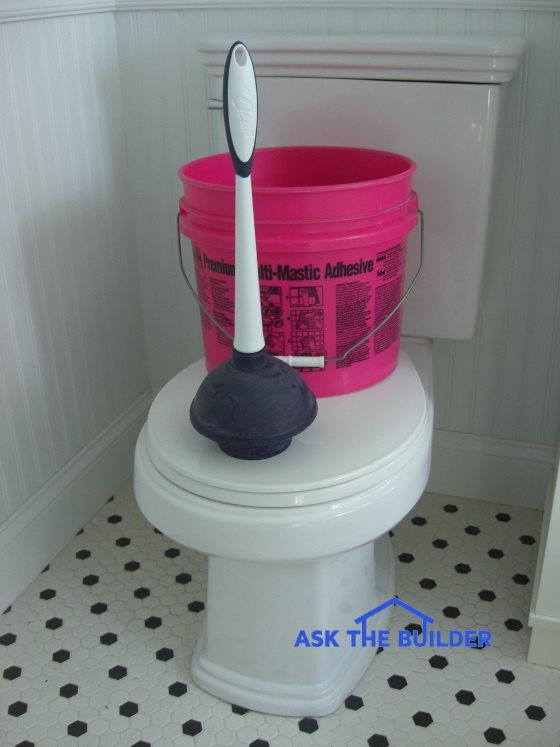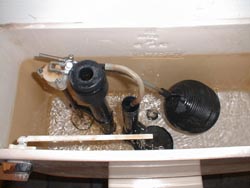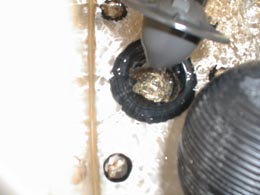Toilet Flush Problems – Easy DIY Fix

Toilet flush problems can be diagnosed with a 3.5 or a 5-gallon bucket. The secret is revealed in the video just below. Watch it for sure. This column was REVISED and shared with the 31,000 subscribers who read my October 12, 2018 AsktheBuilder Newsletter. Copyright 2018 Tim Carter
"Water from the tank rushes to this location to begin to push water and waste out of the bowl. This hole can also be clogged."
Toilet Flush Problems Checklist
- Was the toilet made between 1992 and 1998? Check date inside the tank and under the lid
- Do bucket test to check for clogs
- Check if flapper valve stays open
- Look for hard-water deposits
Toilet Flush Problems - Easy DIY Solutions
Related Links
Muriatic Acid Fixes Slow Flushing Toilets - SECRET Information here - Do NOT Share
Gross Solids Left After Flushing - Gag Me
DEAR TIM: My toilet is giving me fits. It just doesn't seem to flush with the same force that it used to. It also seems to have a mind of its own as water will randomly rush into the tank. This keeps me awake at night. I've tried to adjust the mechanical parts inside the toilet, but the problems still remain. What can I do? Jill S., Scranton, PA
Free & Fast Bids
CLICK HERE to get FREE & FAST BIDS from local plumbers who can fix your toilet.
DEAR JILL: No one likes a pesky or cranky toilet, especially since this necessity is one of the most important and heavily used plumbing fixtures in the average house. Toilet woes frustrate many a homeowner, especially when they lift the tank lid and see all of the rods, chains, levers, floats, etc. The fact of the matter is that toilet mechanics are actually quite simple.
How Does a Toilet Flush?

Typical toilet tank mechanics. The ballcock valve, overflow tube and the flapper valve.
A toilet flushes when a large volume of water enters the toilet bowl in less than two or three seconds.
The flushing action of a toilet is simple physics. The water in the tank sits above the water in the bowl. This tank water has stored energy because of the force of gravity.
When the toilet tank handle is tripped, this water starts to work by pushing the water in the bowl and its contents out of the way and down the drain pipe.
What Limits the Force of the Flush?
The volume of water in the tank, its height above the bowl, restrictions or blockages between the tank and the bowl, or within the bowl all limit the speed and amount of work the tank water can perform.
When were Low-Flush Toilets Required by Law?
Low-flush toilets were mandated by the 1992 Energy Policy Act in an effort to save water. Traditional toilets used 3.5 gallons of water per flush. Toilets built
Why Don't the First Low-Flush Toilets Flush?
Some of the first low-flush toilets were poorly engineered and the 1.6 gallons of water simply couldn't do enough work. The inside channels the water passed through from the tank to the bowl didn't allow the small amount of water to enter the bowl fast enough.
Designs have improved but many consumers still complain about the fact that they have to flush the toilet two or three times to get the bowl clean. This sure doesn't seem to save water!
Can the Fill Valve Be The Problem?
Toilet flush problems can be caused by the fill valve in the tank.
The tank's water level adjustment has slipped. Perhaps your tank is not filling completely. Low water levels in the tank mean less energy to flush.
How Much Water Should Be In the Tank?
The tank water level, when full, should be just below the vertical water overflow tube.
Most tanks have a water fill line stamped in the interior side wall. See if the water level rises to this mark once water stops flowing into the tank. If the water level is low, adjust the fill valve float mechanism so it allows more water to enter the tank. Be sure to always lay the toilet lid flat on the floor when checking the tank. Lids that are leaned against a wall have a strong tendency to slip, fall and crack.
CLICK HERE to get FREE & FAST BIDS from local plumbers who can fix your toilet.
Can Hard Water Cause Toilet Flush Problems?
Toilet flush problems can be associated with blockages created by hard water. Hard water deposits may be blocking they siphon-jet hole in the base of the bowl or the rinse holes located on the underside of the toilet bowl rim.
The siphon-jet hole is about the size of a nickel. It's located at the base of the bowl in many toilets. Water from the tank rushes to this location to begin to push water and waste out of the bowl. This hole can also be clogged. Gently use a Popsicle stick to clean out this opening.
Use a mirror to look at the small holes in the underside of the bowl rim. These holes can get clogged with mineral deposits over time. Use a large wooden toothpick to open these holes. Never use a metal tool to do this. It can quickly chip or crack the china.

This is the hole where water leaves the tank on its way to the bowl. The flapper valve is wide open and in the up position.
Muriatic acid can be used to clear out the hard water deposits. CLICK HERE for detailed instructions on how to use this powerful acid.
Can the Flapper Valve Cause Problems?
Yes, the flapper valve may be closing too fast not allowing enough water into the bowl.
Observe the flapper valve when the toilet flushes. It should stay in the up position until 90 percent of the water leaves the tank. If it drops too soon, it may be waterlogged and/or the chain that lifts it may need to be shortened.
Why Does Water Fill the Tank Without Flushing?
The phantom flushing problem is probably a leaking flapper valve. You can test for this by pouring some red food coloring into the tank after it has filled and the water is calm. Check the toilet in 30 - 60 minutes. If the water in the bowl is pink, this tells you small amounts of water are getting past the flapper valve. When enough water leaks from the tank, the fill valve operates to replace the lost water.
Can Blockages Be in the Tank?
Look at the hole in the bottom of the tank when the black flapper valve is in the up position. See if there are any army men or small boats at the bottom of the drain hole where the tank connects to the toilet bowl. Curious children often play in the water of the toilet tank and toys can get sucked down into the top of the toilet bowl.
CLICK HERE to get FREE & FAST BIDS from local plumbers who can fix your toilet.
Column 332


One Response to Toilet Flush Problems – Easy DIY Fix